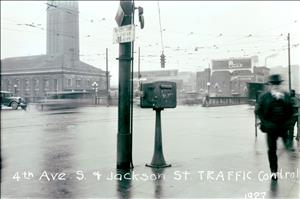On April 21, 1924, Seattle's first automatic traffic light begins part-time operation at 4th Avenue S and Jackson Street. Seattle is actually somewhat late to this party, as traffic lights have been operating in other American cities for as long as a decade. The light proves to be a great success, and they soon will sprout all over the city.
Seattle Sees the Light
The dawn of the automobile in the early twentieth century quickly created a need for traffic control in downtown Seattle intersections. In the earliest years a police officer controlled an intersection with hand signals. Later, Seattle police officers manned semaphore signals in busy intersections, manually turning the pole as needed to direct the flow of traffic. At night a floodlight lit up the officer so people could see him. The problem with this (aside from the obvious danger of getting hit by a car) is that the policeman couldn't pursue or otherwise handle traffic scofflaws. If he left his post to deal with an offender, traffic at the intersection usually descended into chaos.
Seattle was progressive in a lot of ways in the 1920s, but traffic control wasn't one of them. As early as 1912 rudimentary red and green lights mounted on a homemade wooden box were used in Salt Lake City. The first generally accepted electric traffic light was introduced in Cleveland in August 1914. In 1920 the first hanging traffic light, the four-way, three-light signal (and the first traffic signal with a yellow caution light) that we know today, debuted in Detroit. Many American cities had traffic lights before Seattle, but in the spring of 1924 the city saw the light.
The Department of Streets and Sewers ran traffic checks at Seattle's busiest intersections and came up with three candidates for Seattle's first traffic light: 4th Avenue S and Jackson Street, 4th Avenue and Pike Street, and Roy Street and Westlake Avenue. The intersection at 4th Avenue S and Jackson Street was chosen. Of the three, it was the easiest location to install a traffic light at, and there were no other intersections nearby that had traffic police who might inadvertently interfere with the traffic flow at 4th and Jackson. With 24,000 cars passing through the intersection on an average day between 7 a.m. and 10 p.m., the location was the right spot for the light. Planners scheduled a 30-day testing period.
Three Lights and a Gong
A squat iron post was mounted in the center of the intersection, topped by a box rigged with electric lights behind colored glass. In addition to the colors -- red, amber, and green -- a corresponding message, "stop," "traffic change," and "go," appeared on the face of the glass itself. (The messages were to better educate the public about the colors, but they apparently caught on easily enough.) A gong preceded each traffic change but it was hard for motorists to hear, especially when traffic was heavy. Timing of the light in either direction could be adjusted for the flow of traffic, and in this case the optimum timing for the green light was found to be 35 seconds north-south on 4th Avenue and 25 seconds east-west on Jackson Street.
The light began operating on the afternoon of Monday, April 21, 1924, running only during the afternoon and early evening during its first weeks of operation. Testing exceeded expectations. Traffic began clearing up at the intersection by 5:45 p.m., a full half-hour earlier than what the norm had been before the light was installed, and accidents there dropped dramatically. The automated signal was so successful that the police officers monitoring it never used the manual controls during the testing period, and within weeks downtown drivers successfully lobbied to have it turned on during the morning rush hour.

